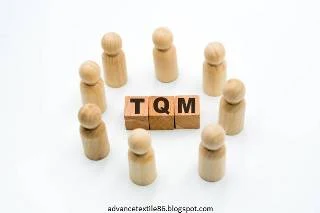Total quality management
Total quality management is made up of the company’s all-out effort to install and create a sustainable climate where employees continuously
improve the efficiency of delivering on-demand products and services that
customers will find special value. Total emphasizes that in addition to sales
and marketing, accounting and finance, engineering and design production, for
example, departments are obliged to improve their activities. Management
emphasizes that executives are obliged to actively manage quality through
funding, training, staffing, and goal setting. Although there is no widespread
consensus, total quality management efforts generally draw heavily on advanced
equipment and quality control strategies.
History of total quality management
The
developed countries of North America and Western Europe suffered economically
in the face of stiff competition from Japan's ability to produce high-quality
products at competitive costs in the late 1970s and early 1980s. The United
States conducted its own self-examination of Japan could ... why can't we? Most
clearly published in television broadcasts. Firms began to re-examine the
quality control strategies invented over the last 50 years and how those
strategies were so successfully employed by the Japanese. It was in this
economic turmoil that total quality management took root.
Total quality management characteristics
i.
From the CEO to the lowest level employee, each company member focuses on
product or service quality. If management is not behind total quality
management, it will fail.
ii.
Everyone must have the necessary training and be familiar with the necessary
total quality management techniques.
iii.
Anyone can suggest areas for improvement - since ordinary workers will be more
familiar with their work center than anyone else, the valuable idea of
improving at a production line level may some cases come from line workers.
iv.
All departments are expected to focus on improving quality and productivity and
implement changes in their areas.
v.
Also, all departments communicate with each other to solve common problems in
the product or process.
vi.
Cooperation on external issues is expected from all departments.
vii.
The decisions made are based on the best solution, not on a secret agenda or
bias.
viii.
Quality becomes a managed part of the activity, with decisions that affect
quality being rejected despite the immediate rejection of cost-saving
involvement.
Total quality management concept/Principle
To
achieve total quality management,
there are some specific guidelines that help them manage the growth of their
systems, these guidelines can also be seen as concepts, below is a list of some
popular concepts. Such as-
i. Continuous quality improvement
Customer
satisfaction is the key to the survival of any business and it requires
continuous work to improve its quality. They must have certain standards that
help them maintain their core values and quality standards and under no
circumstances should the quality of their products and services fall below
these standards.
ii. Employee Involvement in making decisions
Giving
employees autonomy in the way they manage their day-to-day work and involving
them in the decision-making process go a long way in retaining employees,
gaining their loyalty, motivating them, and increasing their commitment. When
management implements the advice given by employees it boosts their morale and
makes them care for their needs. Employees should be rewarded based on their
performance. If an employee comes up with very innovative suggestions that are
implemented, he or she should be rewarded because it will send a signal to
other employees who will work towards finding and delivering innovative
solutions in turn. This will greatly increase their productivity.
iii. Long-term plan
This the organization should work on formulating its plans for the future, i.e., what
they plan to achieve for the next 5-6 years and how they plan to do it. And
then work towards achieving it, they should make decisions that support their
long-term purpose and have periodic review episodes so they can compare if they
are on the right track. This national plan will help them acquire the right
kind of human talent that supports their goals and acquires the kind of skills
necessary to achieve these goals.
iv. Openwork environment
Managers
should welcome employee advice and encourage them to do so without prejudice.
The structure of the organization should be relatively flat so that senior
managers are easily accessible and juniors can consider the ideas given.
v. Customer Focused
All
the steps and decisions that an organization makes must be taken with its
customer in mind, i.e. how the customers will benefit from it. This will
increase overall customer satisfaction. The company can take various steps such
as training its employees and improving internal process management.
vi. Integrated approach
This point applies to organizations where multiple departments and subsidiaries are
working together. With all these sections in mind, a decision needs to be made
about how they are integrated. It should not be the case that one decision
increases the efficiency of one department but decreases the other. The
approach should be collected and how it will affect all departments.
vii. Realistic decision making
Strong
data and evidence should support the decisions that need to be implemented. It
is important not to be emotionally isolated or to have a secret personal agenda
when making and finalizing a decision.
viii. Communication
The effectiveness of successful management depends on how well the decisions made
are communicated to employees so that they are aware of them and can use them to
enhance their work. Any changes to the policies that affect the customer
experience must be well-informed so that they can be successfully implemented.
ix. Strategic and systematic implementation
This
point focuses on the time of implementation. It is very important to make the
right decision at the right time to increase the quality. This is also
strategically important because if a competitor works on similar policies or
strategies, it should not benefit the first runners.










0 Comments